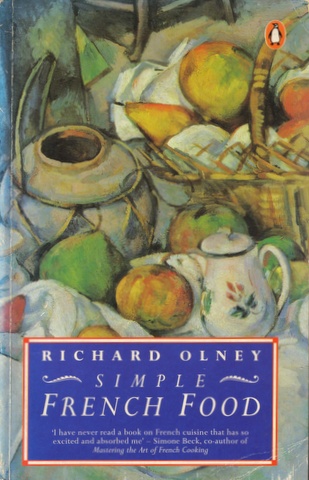Simple French Food – An Introduction
Simple French Food by Richard Olney is a thoughtful, erudite and compelling book from one of the greatest food writers of the last century. Olney’s passion for French food and for simplicity in preparation and presentation shines through every page.
Richard Olney deserves his place as one of the great food writers of the twentieth century, not only because of this book, but for the many books he either wrote or edited such as the 28 volume Good Cook Series that was published by Time Life in the 1970s.
He even managed the difficult task of writing a “coffee table” book called “Provence: The Beautiful Cookbook” which was full of excellent photographs, however the introductions to each chapter were erudite and the recipe selection an excellent representation of the diverse areas of Provence.
There are two great cookbooks about Provence that were written at similar times and within a short distance of each other for a very similar purpose.
One was the famous La Cuisine du Comté de Nice by the mayor of Nice, Jacques Médecin and the other was Simple French Food by American expatriate Richard Olney who lived along the coast near the town of Bandol. The purpose, clearly stated in each book, was a concern about the disappearing culinary traditions of the region.
Médecin was concerned about the younger generation having little regard for the traditional food of the area around Nice with its famous salad, its socca, its daube, its pissaladière, its estocaficada and its tourte de blette.
Olney, on the other hand, wrote a book covering the whole of France but one can tell from the recipes and from the writing that it is really Provence that he is most concerned about.
Simple French Food – The Book
His 35 page introduction to Simple French Food makes this very clear:
The food in this book has been culled from all corners of France, but I have done little to prevent the spirit from veering sharply toward the south, not only because the flavours of Provencal food tend to be direct and uncomplicated, reflecting the sharp clarity of the light and the landscape, but also, in particular, because for the last ten years my shopping has been done in Mediterranean markets, my day-to-day cooking inclines to respect the local formulas, the tables I share are Provençal and perhaps most of all because a certain intimacy has bred an uneasy sense of the gentle dissipation of regional culinary traditions and the need to succour them. The internationalizing influence is not unique to Provence – or to France. My alarm is merely greater.
The Preface then goes on to paint a picture of life in a French village with musings about the traditions attached to cooking and eating. The remainder of the book is divided into nine sections – salads, cold terrines, pates and mousses, eggs, fish, vegetables, starchy preparations, soups, meats and poultry and desserts. These chapters range over both traditional recipes and many that Olney has devised while living in France.
Recipes in Simple French Food that we have particularly enjoyed include the classic leeks in vinaigrette, the pork and herb caillettes from the Ardeche, a savoury turnip omelette, his scrambled eggs, creamed broad beans and bacon, carrot pudding, a soup (tourain) made with onions and white wine, Avignon daube which is based on lamb rather than beef, veal shank in a sorrel cream sauce and then a dessert of dried figs cooked in red wine and fresh thyme. He finishes with instructions for the preparation of the thirteen Provençal Christmas desserts.
Throughout Simple French Food you will be delighted by the beautiful use of words and the imagery he evokes. It is a book you will return to again and again. The deep tradition attached to the recipes also means the book will never become dated.
There is little doubt that this classic by one of the greatest food writers deserves a place in the Foodtourist Top Fifty Coobooks list.
You can buy Simple French Food by clicking on the link below. We receive a small percentage of the sale which goes towards maintaining this site.






















